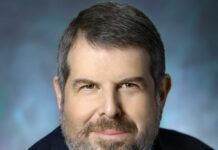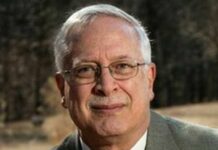Rabbi Sara Mason-Barkin
A flame burns in the Hall of Remembrance of the United States Holocaust Memorial Museum in Washington, D.C.
Above it, are inscribed these words of Torah:
Guard yourself and guard your soul carefully,
lest you forget the things your eyes saw,
and lest these things depart your heart all the days of your life.
You shall make them known to your children, and your children’s children (Deuteronomy 4:9).
As Jews, we visit this museum to remember. We see the replica of the crematorium and we force ourselves to walk through the cattle car. Our trauma is an open wound. The flame burns like a yahrzeit (memorial) candle. In the brittle leather of aging shoes, we see the imprint of our relatives. And in the eyes of portraits hanging on the walls, we see ourselves.
I recently visited the Holocaust Museum in Washington with a group of new friends — the Phoenix Black-Jewish Cohort, and it became an entirely new experience.
This is a group that formed over two years ago in the aftermath of George Floyd’s murder. Paul Rockower, executive director of the Phoenix Jewish Community Relations Council (JCRC) explained that the vision was — and is — to bring together young Black and Jewish leaders from the Phoenix community. Together we sought to simply know each other. The goal is simple: to build deep relationships that are not just symbolic, but true.
Lawyer and activist Bryan Stevenson calls this “getting proximate.” By being in proximity to those who are marginalized, we change stories about “someone” to stories about someone we love. We learn that by standing together in our vulnerable moments, we ease each other’s pain. Stevenson writes, “There is power when we get proximate, and only then can we have mercy and compassion.”
It is like our sages teach: “that to love — truly to love — means to know what brings pain to your fellow human being” (“The Sages Speak,” William B. Silverman).
Our cohort is made up of eight Phoenix leaders: four from the Jewish community and four from the Black community. We began meeting over Zoom, and we only just met each other in person for the first time a few months ago. The idea of traveling together felt new, risky, a little uncomfortable and very exciting. With a generous civic incubation grant from Jewish Federations of North America, we were able to make this trip a reality.
Outside the Hall of Remembrance, the eight of us huddled in a tight circle. We felt the power of proximity. I led our group in the mourner’s kaddish.
“This prayer is both an acknowledgement of memory and also an appreciation of life,” I explained. “It is not only an expression of sadness, but also an affirmation that life is for the living.”
The Jewish members of our group said the prayer, and we all said amen.
Amen. From the Hebrew verb l’ha’amin — “to agree,” or, “I believe this is true.”
Amen is a prayer that we can say together, a prayer of proximity.
The next morning, we set out for the National Museum of African American History and Culture. The rectangular bronze lattice-like building stands in juxtaposition to the tall, narrow walls of the Washington monument. The history of the monument is complicated: It was built in the 1800s, in large part by enslaved Africans. It honors George Washington, who owned hundreds of slaves. Even before entering the museum, we examine our relationship to slavery, freedom and the journey from one to the other.
A glass elevator inside serves as a time machine, bringing visitors back to the 1400s. On the bottom floor of the museum, I stood at the helm of a reconstructed slave ship. I peeked inside a slave cabin. I read brutal stories.
I took a few extra moments to stand before the casket that once held the body of Emmett Till. I mourned the 14-year-old boy who was lynched by men who believed he whistled at a white woman in a grocery store. I saw the pain in the photograph of his mother’s face as she buried her son.
And yet, as we made our way forward through the timeline of African American history, we bore witness to progress. The top floor of the museum feels lighter and brighter. It highlights the accomplishments of the African American community. It is a celebration of music and sports and television and science. Reunited with my group, we felt the proud power of the present.
But the present is painful, too. Moments after I stood alone before Emmet Till’s casket, Blacks and Jews stood together before a glass case holding Trayvon Martin’s bullet-riddled hoodie. There were his shoes, and the bag of skittles that he bought just before his death.
How can we say we love our neighbor unless we see their pain? Amen, friends. Your trauma, too, is an open wound.
At dinner that night, my colleague, Pastor Warren Stewart Jr. explained: “All that history reminds me, I’m a survivor. All that trauma, and I’m here.”
Amen. We all agreed. We are here because of the grit, the perseverance, and the luck of the survivors who came before us and the survivors who are us.
Our phones pinged then, with a news notification. Ten Black people shot in a Buffalo supermarket. Our hearts that had just begun to heal shattered again, 10 times over.
This news hurt in a new and specific way.
It hurt because I could see the pain in my friend’s eyes and I hope that they saw the love in mine. In proximity we can truly love our neighbor.
Before we left the Museum of African American History and Culture, our group stood together before the rushing water pouring down like rain in the center of the Contemplative Court. On the wall we read: “We are determined… to work and fight until justice rains down like water and righteousness like a mighty stream.”
As Jews, we visit this museum to remember. We see a casket, and a bullet-ridden sweatshirt. A mother’s tears.
We bear witness: Lest you forget the things your eyes saw, and lest these things depart your heart all the days of your life.
This is the purpose of memory. We burn with a fiery hope for justice and thunderous drive for peace. Let my fire be proximate to your water, for this is how we will change the world.
Rabbi Sara Mason-Barkin is the executive educator at Congregation Beth Israel in Scottsdale, Ariz.





